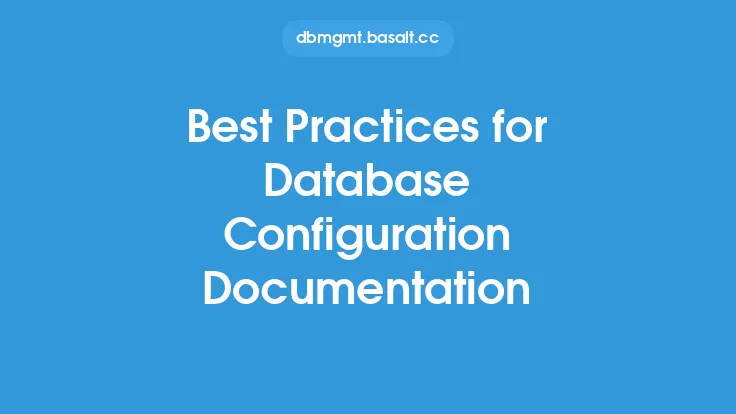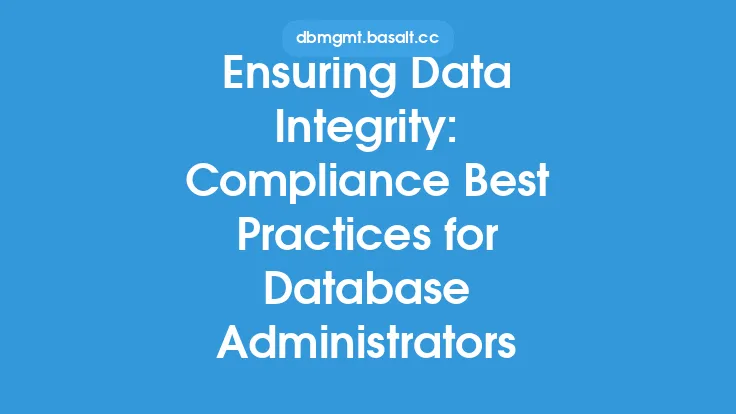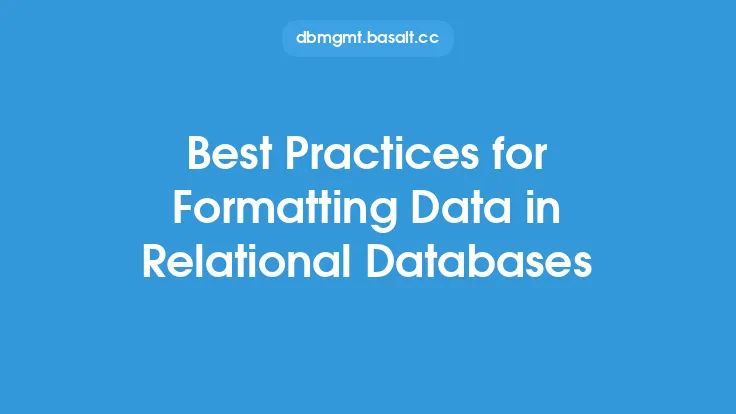Organizing database documentation is a critical aspect of database administration, as it ensures that all stakeholders have access to accurate and up-to-date information about the database structure, relationships, and dependencies. Effective organization of database documentation is essential for maintaining data integrity, reducing errors, and improving overall database performance. In this article, we will discuss the best practices for organizing database documentation, including the importance of standardization, version control, and accessibility.
Standardization of Database Documentation
Standardization is the foundation of effective database documentation organization. It involves establishing a consistent format, structure, and content for all documentation, making it easier for users to navigate and understand. Standardization also helps to reduce errors and inconsistencies, which can lead to data corruption or loss. To achieve standardization, database administrators should establish a set of guidelines and templates for creating and updating documentation. These guidelines should include rules for naming conventions, data types, and relationships, as well as standards for formatting and content.
Version Control and Change Management
Version control and change management are critical components of database documentation organization. As databases evolve, documentation must be updated to reflect changes to the structure, relationships, and dependencies. Version control systems, such as Git or Subversion, can help to track changes to documentation and ensure that all stakeholders have access to the latest version. Change management involves establishing a process for reviewing, approving, and implementing changes to the database, ensuring that all documentation is updated accordingly. This helps to prevent errors and inconsistencies, and ensures that all stakeholders have a clear understanding of the database structure and relationships.
Accessibility and Searchability of Database Documentation
Accessibility and searchability are essential for effective database documentation organization. Documentation should be easily accessible to all stakeholders, including database administrators, developers, and end-users. This can be achieved by storing documentation in a centralized location, such as a wiki or document management system, and providing clear navigation and search functionality. Searchability is also critical, as it enables users to quickly find specific information or documentation. Database administrators should use keywords, tags, and metadata to make documentation searchable, and provide clear instructions for searching and accessing documentation.
Database Documentation Templates and Examples
Using templates and examples can help to simplify the process of creating and updating database documentation. Templates provide a standard format and structure for documentation, ensuring consistency and reducing errors. Examples can help to illustrate complex concepts and relationships, making it easier for users to understand the database structure and dependencies. Database administrators should create a set of templates and examples for common database objects, such as tables, views, and stored procedures, and provide guidance on how to use them effectively.
Security and Access Control for Database Documentation
Security and access control are critical components of database documentation organization. Documentation should be protected from unauthorized access, as it may contain sensitive information about the database structure and relationships. Database administrators should establish access controls, such as user authentication and authorization, to ensure that only authorized users have access to documentation. Additionally, documentation should be encrypted and stored in a secure location, such as a encrypted file system or document management system.
Best Practices for Database Documentation Organization
In addition to standardization, version control, accessibility, and security, there are several best practices that database administrators should follow when organizing database documentation. These include:
- Using a consistent naming convention for database objects and documentation
- Providing clear and concise descriptions of database objects and relationships
- Using diagrams and visualizations to illustrate complex concepts and relationships
- Establishing a process for reviewing and updating documentation regularly
- Providing training and support for users to ensure they understand how to access and use documentation effectively
- Using automation tools to generate documentation and reduce errors
Tools and Technologies for Database Documentation Organization
There are several tools and technologies available to help database administrators organize database documentation. These include:
- Document management systems, such as SharePoint or Confluence
- Wiki platforms, such as MediaWiki or TWiki
- Version control systems, such as Git or Subversion
- Database documentation tools, such as Data Dictionary or DBDoc
- Automation tools, such as SQL scripts or batch files
Conclusion
Organizing database documentation is a critical aspect of database administration, as it ensures that all stakeholders have access to accurate and up-to-date information about the database structure, relationships, and dependencies. By following best practices, such as standardization, version control, and accessibility, database administrators can ensure that documentation is effective, efficient, and secure. Additionally, using tools and technologies, such as document management systems and automation tools, can help to simplify the process of creating and updating documentation, and reduce errors and inconsistencies. By prioritizing database documentation organization, database administrators can improve overall database performance, reduce errors, and ensure data integrity.





